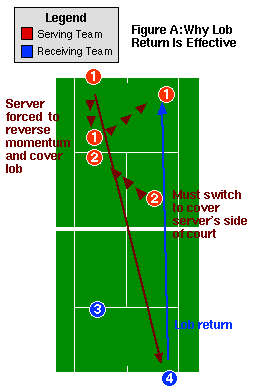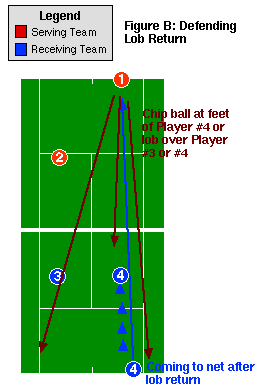|
TennisOne Lessons

Strategy Lesson
of the Week
Handling the Lob Return in Doubles:
Part 2: Defending
By Monty Basynat, TennisONE Editor
In Part 1 of the lessons focused on how a doubles team should handle the
lob return, I focused on how to prevent a team from lobbing the
return. In this lesson, we'll focus on what to do if your opponents' lob
return is successful. Why spend so much time focusing on this one
subject? Well, the lob return is one of the three basic options for the
returner in doubles. The other two are: 1) your basic crosscourt reply;
2) down the line towards the net person.
Option number three, lob over the net person's head, is a very good tactic
and unless your team knows how to respond, it can cost you the match.
In many instances, successful the lob return allows the returning
team to move from a defensive posture to an offense posture, as it enables
the returning team to come to the net while the serving team must retreat
to the baseline (or assume a one up/one back position, which is inherently
weak when facing a team that comes to the net).
How to react to a successful lob return depends on several variables,
including:
- What the receiving team does after the lob (comes to net or stays
back).
- How penetrating the lob return is.
- What the server does after serving (comes to net or stays back).
- Whether your team has to handle the lob return from the forehand or
backhand side.
The dynamic interplay of all these variables is what makes doubles such
a great game-in many ways, a different, more complex game than singles.
The doubles team that more quickly and intuitively understands how these
variables are working, will be the team that will make the best shot selection
and usually win the point.
In Part 2 of these lesson, I'll discuss how your team should defend your
opponents' lob return strategy.
 As I reminded you in Part 1, the serving
team in doubles should try to maintain its inherent offensive advantage
of serving by serving and coming the net. So if you like to serve and come
to the net, you should continue to pursue this strategy until the returning
team proves it can successfully defeat that strategy: in this instance,
by successfully lobbing over your net partner's head. As I reminded you in Part 1, the serving
team in doubles should try to maintain its inherent offensive advantage
of serving by serving and coming the net. So if you like to serve and come
to the net, you should continue to pursue this strategy until the returning
team proves it can successfully defeat that strategy: in this instance,
by successfully lobbing over your net partner's head.
If you are a serve-and-volley player, a successful lob return will
generally throw you into a defensive posture. As the diagram shows,
you, as Player #1, will be heading to the service line after your serve
and a successful lob over your partner's head will force you to quickly
reverse your body momentum and scramble back to the other side of the court.
 Since you usually are beating a hasty retreat
to handle this lob return, you should be thinking of hitting a defensive
shot in reply in this situation. If Player #4 is coming to the net after
lobbing, you have the following options: 1) chip or slice a return at the
onrushing feet of Player #4; 2) lob over Player #3; 3) lob over Player #4.
The advantage of hitting a defensive lob over your opponents is that
this allows you and your partner more time to assume a better court position
and set up for the next shot. If your lob is good enough, it may
even allow your team to come in and regain control of the net. Since you usually are beating a hasty retreat
to handle this lob return, you should be thinking of hitting a defensive
shot in reply in this situation. If Player #4 is coming to the net after
lobbing, you have the following options: 1) chip or slice a return at the
onrushing feet of Player #4; 2) lob over Player #3; 3) lob over Player #4.
The advantage of hitting a defensive lob over your opponents is that
this allows you and your partner more time to assume a better court position
and set up for the next shot. If your lob is good enough, it may
even allow your team to come in and regain control of the net.
Send in Your Strategy Questions to TennisONE
If you think you have a good TennisONE Strategy Question, please send an
email to: question@tennisone.com.
|
|
|